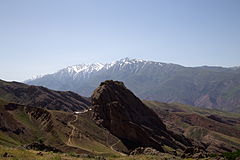
Back قلعة ألموت Arabic قلعة الموت ARZ Ələmut qalası Azerbaijani الموت قالاسی AZB Аламут Bulgarian Fortalesa d'Alamut Catalan قەڵای ئەلەموت CKB Alamút Czech Alamut German Αλαμούτ (κάστρο) Greek
| Alamut Castle | |
|---|---|
الموت | |
 The rock of Alamut | |
| General information | |
| Status | Ruined, partially restored |
| Type | Castle |
| Architectural style | Iranian |
| Location | Alamut region, Qazvin Province of Iran (Historically also: Tabaristan) |
| Town or city | Moallem Kalayeh |
| Country | Iran |
| Coordinates | 36°26′41″N 50°35′10″E / 36.44472°N 50.58611°E |
| Completed | 865 |
| Destroyed | 1256 |
Alamut (Persian: الموت, lit. 'eagle's nest') is a mountain fortress at an altitude of 2163 meters at the central Alborz, in the Iranian stanza of Qazvin, about 100 kilometers from Tehran. In 1090 AD, the Alamut Castle, a mountain fortress in present-day Iran, came into the possession of Hassan-i Sabbah, a champion of the Nizari Ismaili cause. Until 1256, Alamut functioned as the headquarters of the Nizari Ismaili state, which included a series of strategic strongholds scattered throughout Persia and Syria, with each stronghold being surrounded by swathes of hostile territory.
Alamut, which is the most famous of these strongholds, was thought impregnable to any military attack and was fabled for its heavenly gardens, library, and laboratories where philosophers, scientists, and theologians could debate in intellectual freedom.[1]
The stronghold survived adversaries including the Seljuq and Khwarezmian empires. In 1256, Rukn al-Din Khurshah surrendered the fortress to the invading Mongols, who dismantled it and destroyed its famous library holdings. Though commonly assumed that the Mongol conquest obliterated the Nizari Ismailis presence at Alamut, the fortress was recaptured in 1275 by Nizari forces, demonstrating that while the destruction and damage to the Ismailis in that region was extensive, it was not the complete annihilation attempted by the Mongols. However, the castle was seized once again and fell under the rule of Hulagu Khan’s eldest son in 1282. Afterward, the castle was of only regional significance, passing through the hands of various local powers.
Today, it lies in ruins.
- ^ Daftary, Farhad (1998). The Ismailis. Cambridge, UK: Cambridge University Press. ISBN 0-521-42974-9.
© MMXXIII Rich X Search. We shall prevail. All rights reserved. Rich X Search
